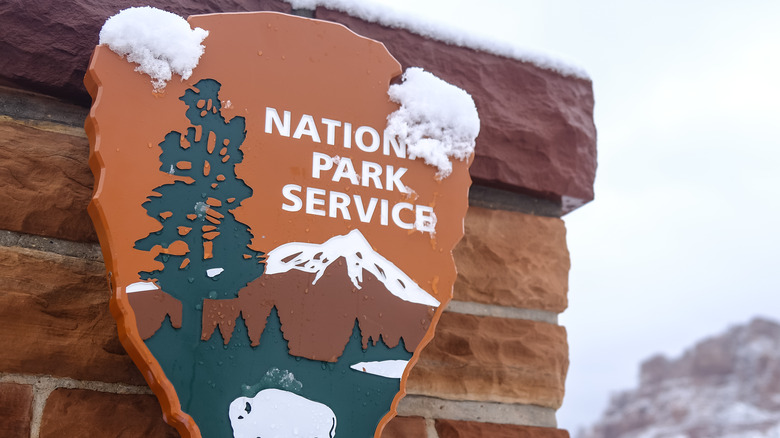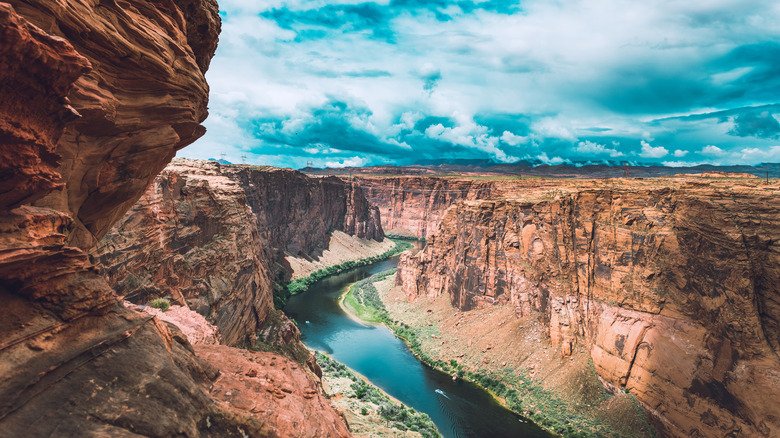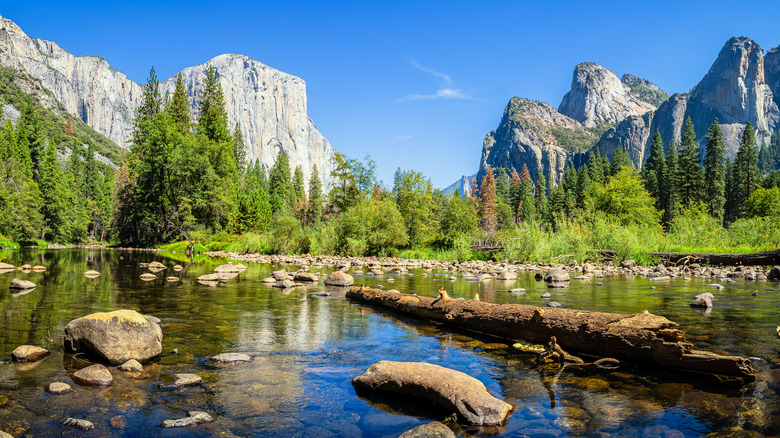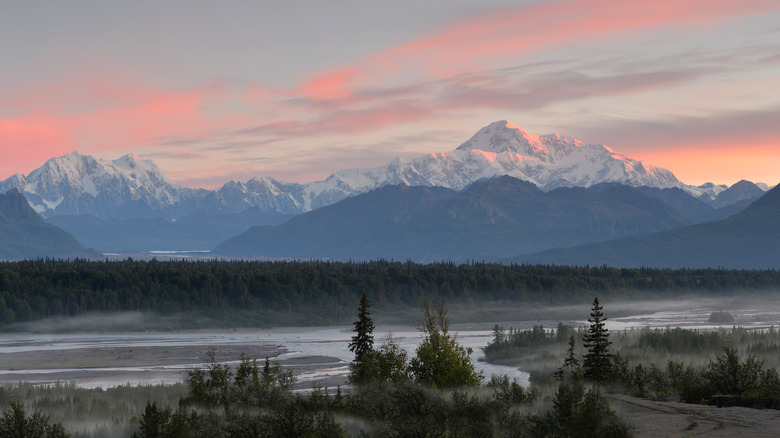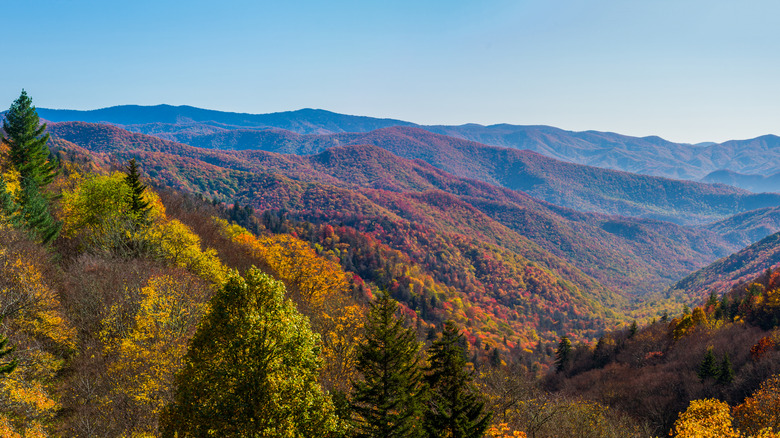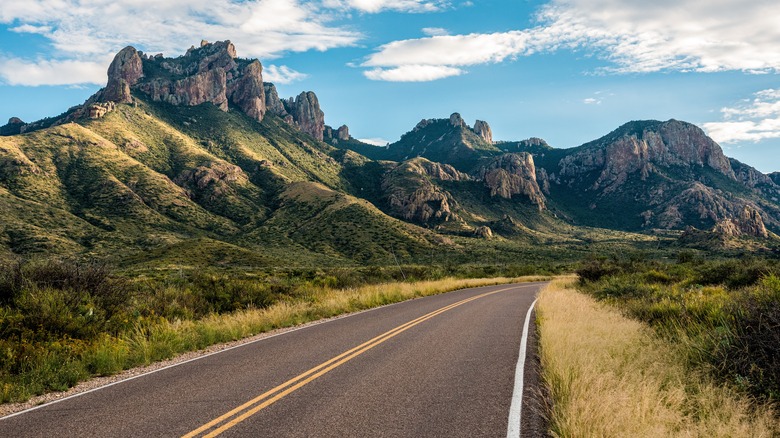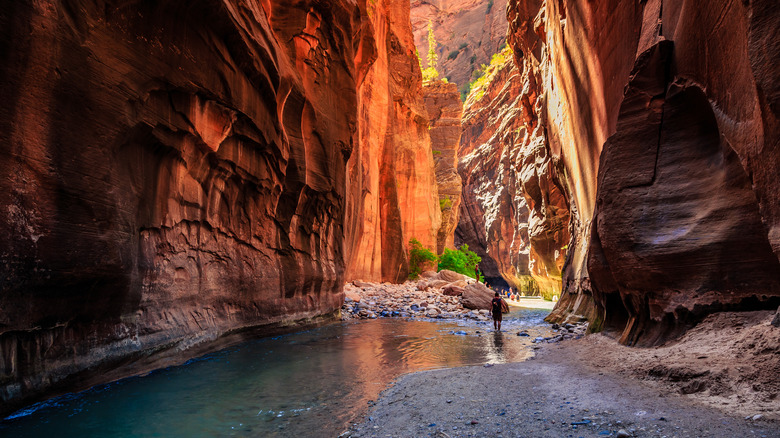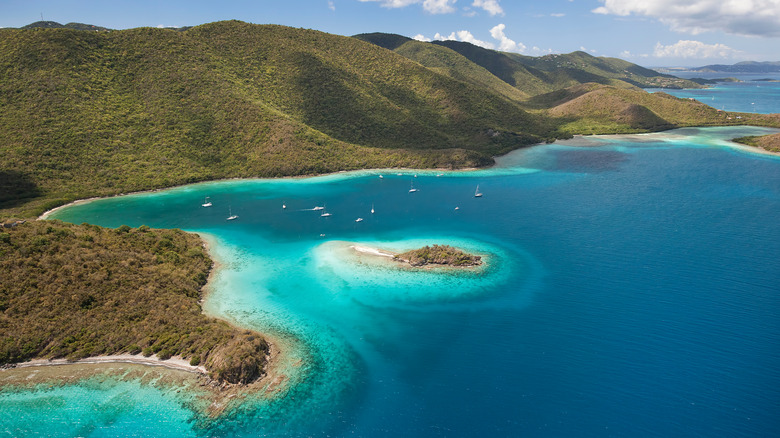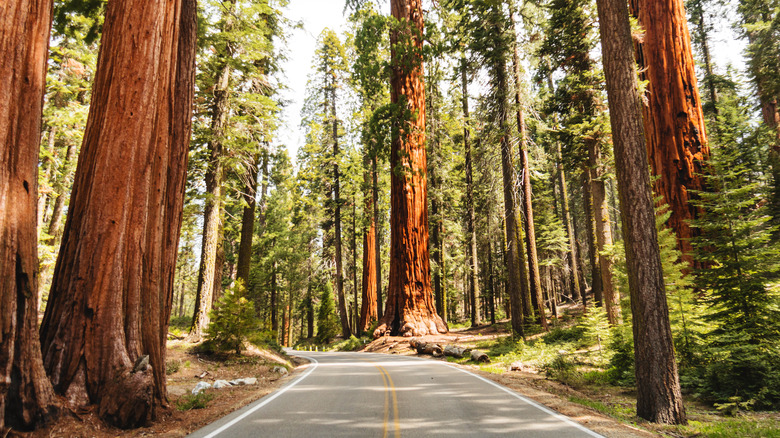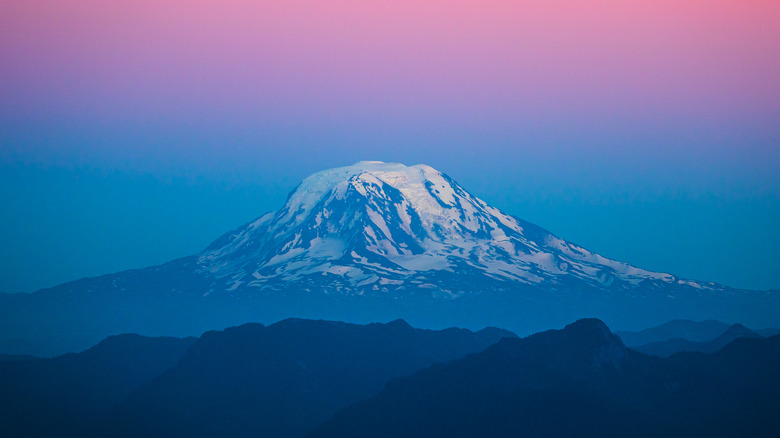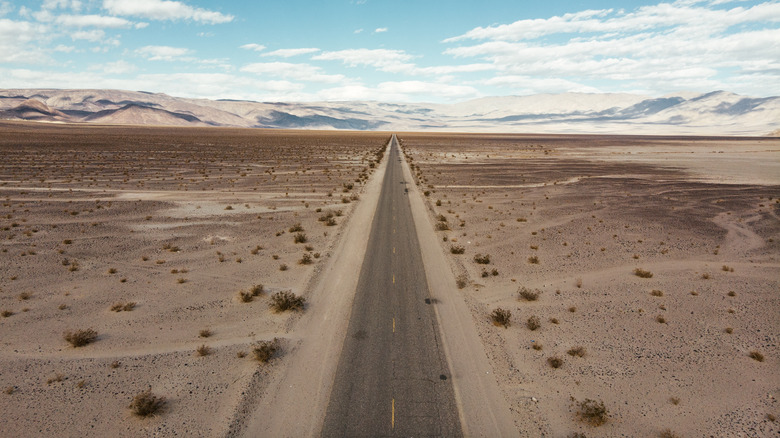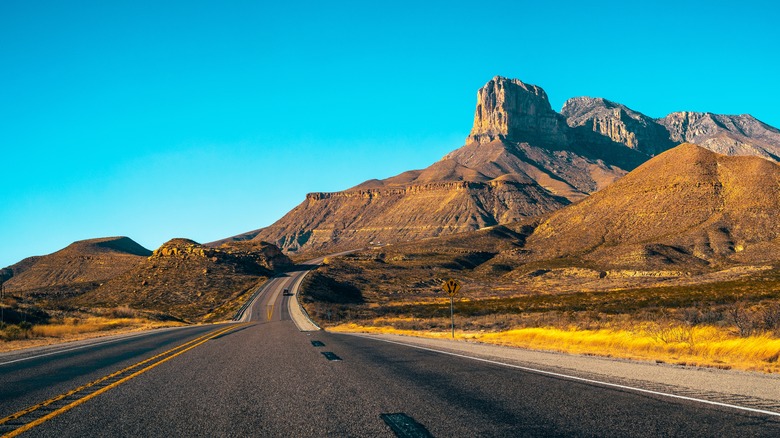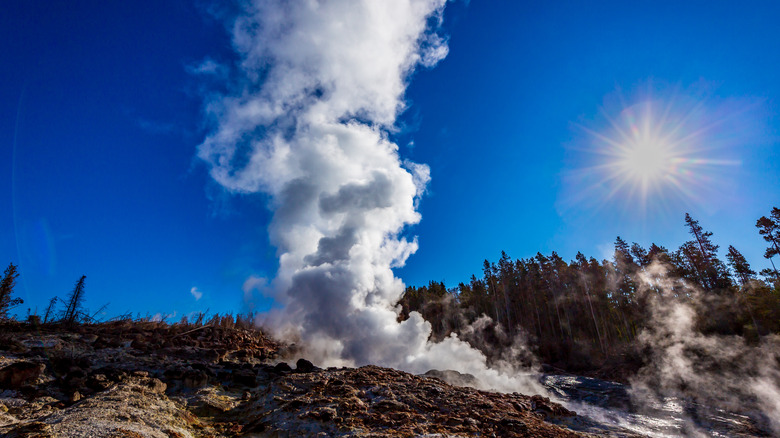The Most Dangerous US National Parks
No place or activity is without its dangers. You take your life in your hands whenever you get behind the wheel of a car, cross the street, swim in a pool, or go on a hike in the woods. This isn't meant to frighten you, just present you with a reality. So, when we say that there is inherent danger present at the national parks, we are not suggesting that you shouldn't visit them. You just need to be aware of the risks involved.
Though beautiful and breathtaking in their own right, the National Parks of the United States have claimed somewhere around 3,000 deaths per 3.5 billion visitors since 2007. To put that into perspective, that's roughly eight deaths per 10 million people, per PSBR Law. Based on that data, you can rest assured that the parks are, overall, very safe places to visit. However, there are some that present a more clear level of danger.
Some of the parks on this list will be familiar to anyone who has done the research required to determine which parks present the most danger. Many of them are extremely popular, while others are hardly visited at all. Note, however, that we are not ranking the parks from most to least dangerous. We're simply providing you with a data-centered list of the 12 most dangerous U.S. national parks.
Grand Canyon National Park
You have to ask yourself: how could an enormous, miles long, wide, and deep crack in the earth not be among the most dangerous places in the United States? Well, the Grand Canyon is just that, having been host to 134 deaths since 2007. It presents many natural dangers, not the least of which is the fact that you could likely fall to your doom if you happen to slip while walking too close to the edge. However, the biggest killer at the Grand Canyon is not falling. It's the weather.
A great majority of the six deaths and 56 people who have gone missing at the Grand Canyons since 2018 have been related to weather events. This includes heat stroke, lightning strikes, and heat exhaustion. The Canyon presents extreme changes in temperature. Though the upper rims can be relatively cool, the base has been known to reach up to 120 degrees Fahrenheit in full sun. Most people hike down into the Canyon, and might not realize just how dramatic the temperature shift can be during their journey.
These weather-related deaths can easily be avoided by visiting the Canyon in the fall or spring when the temperatures are more mild. Just be prepared with plenty of water and good shoes for your descent. Other causes of death at the Grand Canyon have included drowning in the Colorado River, air crashes, and accidental falls.
Yosemite National Park
The brainchild of America's most famous naturalist, John Muir, Yosemite National Park in California is one of the most beautiful places in the United States. From its great rivers, majestic waterfalls, dramatic trees, and abundant wildlife, there is something to love at Yosemite for every brand of nature lover. However, beneath that natural beauty lurks a decent amount of danger. Since 2007, Yosemite has been host to over 100 deaths, making the current fatality rate 28.01 deaths per 10.8 million visitors.
What's the cause of all these deaths, you ask? Well, at least 25% of them were the drownings in the Merced River. This is likely so common because in the early spring, the river swells from the winter runoff, causing extremely high water levels and very swift moving currents. Anyone who falls into the icy winter runoff is going to be carried away with the current and will more than likely not escape with their lives.
If you are unsure about how best to proceed when faced with crossing or swimming in the river, park rangers are available to help you. Other causes of death at Yosemite were from motor vehicle accidents, rock falls, slips, and medical causes, like heart attacks or strokes.
Denali National Park and Preserve
High in the great northern enigma that is Alaska is Denali National Park and Preserve. Mount Denali, or Mount McKinley depending on who you ask, is the peak which gives the park its name. It is a checkmark on the list of climbing achievements for many mountaineers. Long considered one of the world's most extreme, and dangerous sports, it should come as no shock that mountain climbing is the leading cause of death at Denali National Park.
Denali has claimed 129 deaths since 1932, with 51 of those deaths occurring since 2007. Like the Grand Canyon in Arizona, weather changes are among the most deadly natural events to occur on Denali. Subzero temperatures, high winds, and even extremes in heat, have caused many deaths on the slopes, as have ill timed gear failures, slips, falls, avalanches, lack of oxygen, and the many other risks associated with climbing a mountain.
Long seen as the wildest of all the National Parks, especially wildlife, Denial claims an average of 9.8 deaths per 1 million visitors. Accidents, mountain climbing or otherwise, are the chief cause. And though Alaska has one of the most concentrated bear populations in the world, only one fatal bear attack has been reported in the park's century of existence.
Great Smoky Mountains National Park
The Great Smoky Mountains in North Carolina and Tennessee are relatively immune to the extremes in weather we've talked about thus far. And, as far as park safety goes, when you're there, you stand very little risk of being harmed by other environmental factors. So, why is it, then, that Great Smoky Mountains National Park has seen 92 deaths over the last 10 years? Two words: car accidents.
The Great Smoky Mountains has roughly 384 miles worth of roads crisscrossing its interior. These roads include U.S. 441, the Foothills Parkway, and Newfound Gap Road. This puts Great Smoky Mountains smack in the middle of a commuting zone, one that sees a significant increase in traffic during tourist season. As the park sees some 12 million plus visitors a year, things can get crowded pretty quickly.
A lot of the motor vehicle incidents have been attributed to speeding, drunk driving, and plain inattentiveness. 37 crashes, several of which have left people either dead or seriously injured, have been reported in the park since 2007. So, really pay attention when you go to the Great Smoky Mountains. Your best bet for safety is your own knowledge and vigilance of the road.
Big Bend National Park
Heading into Big Bend National Park in southern Texas, you'll notice two things. First, that it's not very crowded. Two, that the desert stretches on forever and ever. Not one of the more visited of the National Parks, only seeing a few hundred thousand every year in comparison to the tens of millions of visitors to other parks, Big Bend is still notoriously dangerous for a couple of different reasons. We'll leave you to guess what the chief one is.
You've got it: dehydration. One of the things you are not likely to find in Big Bend is a reliable water source or shady area. Don't underestimate the power of raw sunshine, even on days when outdoor temperatures are cool. If you plan on hiking around Big Bend, make sure that you are equipped with plenty of water so that you are constantly hydrating. This is especially true if you have children, who are very susceptible to dehydration and heat exhaustion.
Road hazards abound as well. From stopped cars viewing wildlife, to said wildlife crossing the roads, sharp bends, and thin lanes, you need to be on the lookout. Also, make sure you've got a full tank of gas if you're planning on doing a driving tour of the whole park. Getting stranded is the last thing you want in an area populated by bears, mountain lions, and rattlesnakes.
Zion National Park
You might think, given the fact it is located in the middle of the desert, that Zion National Park in Utah would be free of environmental hazards like rain. Rest assured, this is not the case. Flash flooding has been known to kill visitors on a yearly basis. Quite common in the Zion and the southwestern desert, flash flooding is the result of a heavy amount of rain being dropped onto the desert floor all at once. As the ground cannot absorb all of the water, a veritable flood is created that has the capacity to wipe out virtually everything in its path, including loaded automobiles, trees, and boulders. Anyone unfortunate to be caught in one is not likely to survive.
Another hazard in Zion are the seemingly harmless sandstone canyons. Sandstone is notorious for being beautiful, but also for being smooth and soft. As a result, the trails on the canyons can be slippery. Unsuspecting hikers could easily lose their balance and fall if they are not careful. This is especially true at Emerald Pools, where water only adds to the slippery nature.
So, wear the correct footwear and be wary of the weather. If there is a chance that flash flooding might occur, and there's always a chance, plan your visit for another day. Flash flood warnings are not to be taken lightly, even in the desert.
Virgin Islands National Park
Owing to its status as an island, Virgin Islands National Park is Number One on the list for drowning deaths at the National Parks. This is not the fault of the park itself, other than the fact that one of the main things that attracts the several million visitors per year is the wonderfully warm, tropical water surrounding the islands. That water just happens to be the main cause of the parks 6 deaths per 1 million visitors.
Besides drowning, there is a fair amount of dangerous marine wildlife that requires caution. The U.S. Virgin islands are home to several varieties of shark, as well as sea wasp jellyfish, barracuda, fire coral, long-spined sea urchins, moray eels, and many more. So, do your best to avoid any type of marine life while swimming at the park. Be especially cautious in summer, as that is when the sea wasp jellyfish, which can cause anaphylaxis and scarring, are at their most common.
One really needs to be careful when partaking in any kind of water-related activity at Virgin Islands National Park. The beauty of the waters and wonderfully tropical scenery should not cloud your judgment on the many dangers present.
Redwoods National Park
It seems that we can place the danger blame at many of the parks on this list not so much on the literal nature of the parks themselves, but on the additions mankind has made to them. For example, U.S. 101 is the main artery that runs through Redwoods National Park in northern California. As a result of it passing through the park, the number one danger is, of course, auto accidents. The scenic route travels all the way along the northern coast of California and sees a tremendous amount of traffic. Several of the 21 fatalities that have occurred at Redwoods over the last 13 years have been auto-related.
This does not mean, however, that one should not be wary of the other natural dangers present at the park. Sneaker waves, tides, and water temperature, for instance, can easily cause cases of hypothermia, injury, and drowning. Pacific water is, surprisingly to some, notoriously cold, especially the farther north you go. The longer you spend in cold water without the proper gear, the likelier you are to get hypothermia.
So while there are environmental factors to take into account, it's the man-made ones at Redwoods that are, indeed, the most dangerous. This has resulted in the park averaging 36.6 deaths per 10 million visitors.
Mt. Rainier National Park
First things first: Mount Rainier is a volcano. Though it hasn't erupted in over 2,000 years, it is still very much an active, working volcano. While that should not stop you from visiting, understand that to hike an active volcano comes with the inherent risk of being present when it does eventually decide to erupt again. However, volcanic eruptions are not what has caused the over 400 deaths on Mount Rainier since 1897.
Much like its northern cousin, Mount Denali, Mount Rainier has seen many hikers and climbers go missing due to ill preparedness to deal with the drastic weather changes and environmental hazards present on the mountain. Mudslides, for one thing, are rather destructive due to their speed and viscosity. Other factors, such as plane crashes, rock falls, avalanches, asphyxiation, and hypothermia make Mount Rainier no mountain to be trifled with.
There are plenty of safety precautions you can take if you're planning on climbing or hiking Rainier. There are several trails that are routinely patrolled by park rangers, and a number of safety measures are in place. However, at the end of the day, it's down to the climber's smarts and skill — and the mountain's mercy.
Death Valley National Park
You might think that, given its name and status as the hottest place on Earth, the most dangerous aspect of Death Valley in California would be, well, the heat. And while there have been no shortage of deaths caused by this sweltering environment, the number one cause of death in Death Valley is our friend the automobile.
14 of the 41 deaths reported in Death Valley between 2010 and 2020 were auto related. U.S. highway 190 travels through the park, making it, again, an epicenter for both park travel and regular commuting. Route 190 crosses most of southern California and brings drivers into Nevada. It's a well-traveled, scenic route, with changes in elevation that can wreak havoc on a car's brakes.
This does not mean, however, that you should not be wary of the heat when traversing Death Valley. Like at Big Bend, if you're outside hiking, make sure you have plenty of water and sun protection with you. Heat stroke is nothing to joke about, so plan accordingly if you are going to be spending any amount of time outside in Death Valley.
Guadalupe Mountains National Park
Another National Park that is not overly trafficked by visitors, Guadalupe Mountains in Texas remains quite dangerous. Much like Zion, Guadalupe Mountains is a climbing nightmare. The limestone rocks that make up a majority of the natural structures at the park are fractured in such a way that portions of it can easily be dislodged should one try to climb them. This makes falls extremely likely, and dangerous. Which is why, at the park itself, rock climbing is not allowed due to concerns for safety.
However, only two deaths have been reported from natural causes in the 10 year study period we've mentioned throughout this list. The remaining three out of the five fatalities reported at the park have all been motor vehicle accidents. High winds, sometimes with gusts upwards of 80 mph, are also cause for concern when hiking in Guadalupe.
Since it is so little visited, seeing just over 200,000 visitors in a given year, the danger level presented by the park is minimal. However, you should nevertheless be careful when you visit, as wildlife, weather, and lack of water are also cause for safety concerns.
Yellowstone National Park
Rounding out our list is, perhaps, the most popular and legendary National Park of them all. The one that started it all: Yellowstone. Now, it's not Kevin Costner and gangs of tough ranch hands that are going to get you killed at this iconic national park. Oh no, it's something far more grisly. The thing that will get you killed at Yellowstone is actually the hot springs.
Don't believe us? Well, according to the BBC, in 2016, a man illegally jumped into the Norris Basin. As a result of his ill-advised move, he was boiled to death and his remains were dissolved inside the Basin. The high acidity and temperature of the geothermal heated water were to blame for the lack of physical evidence. Of course, Yellowstone has its fair share of traffic incidents and deadly encounters with wildlife, but the thermal areas present the most cause for danger.
While visiting any of these national parks comes with their fair share of risks, don't for a second believe that if you keep your head and follow park rules that you won't come out the other end safe and sound. Don't give up on visiting these treasures just because some people have jumped into boiling basins or slipped down a cliff face. These parks are only as dangerous as you make them. So, be careful, and enjoy the adventure.
